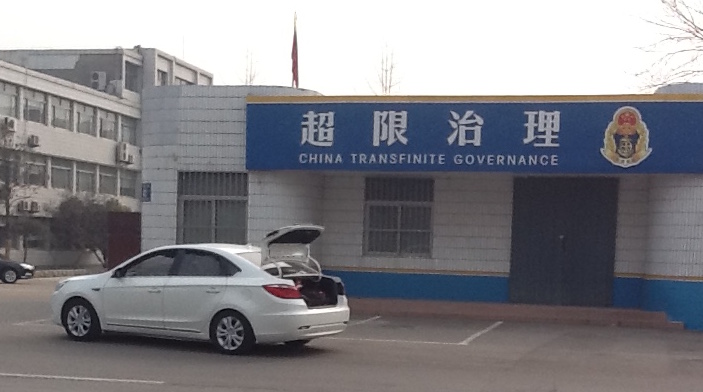Hyper-Confucian government
« previous post | next post »
This picture shows the main entrance to a public agency office in Qufu, home town of China's greatest philosopher of government, Confucius.
The sign says:
chāoxiàn zhìlǐ 超限治理
("overload control")
The wording is not a slogan. It identifies the specific role of this agency, which is a branch of the Traffic Police that deals with overloaded trucks.
"Transfinite" is a possible translation of chāoxiàn 超限, as in chāoxiàn dìguī 超限递归 ("transfinite recursion"), but I wonder what would happen to a poor transgressing trucker if he were subjected to it.
[Thanks to Chris Godwin]

Rubrick said,
March 24, 2016 @ 10:16 pm
Well, "Canton" is only one character off from "Cantor". ;-)
Vilinthril said,
March 25, 2016 @ 4:48 am
As a mathematician working in set theory, I'm all for transfinite governance.
V said,
March 25, 2016 @ 2:53 pm
Are overloaded trucks a large enough problem to require a distinct agency occupying an entire building to oversee them!?
Matt McIrvin said,
March 25, 2016 @ 3:09 pm
Well, American highways have roadside weigh stations to deal with this. Most US states seem to have an office of the Division of Motor Vehicles or equivalent called something like "Commercial Vehicle Enforcement" that runs these stations; I suppose that would be the equivalent.
Chris Godwin said,
March 26, 2016 @ 1:55 am
Reply to V: Visitors to China from N Am or Europe are likely to be astonished by the length, width, height and cumbersomeness of loads carried on China's highways! So yes, there's a need for the Transfinite Police.
andyb said,
March 27, 2016 @ 3:11 am
A transfinite truck seems like a bad idea, but a transfinite train could be useful. You'd only need a single train for each track, and you could always insert or remove a car anywhere along the line without interfering with more than 0% of the other traffic. And you could have vastly many sections of the train moving at whatever forward speed you like, while the train as a whole still has a net speed of 0—in which case, the net fuel and maintenance cost of the train is 0. Of course the startup costs are a little high…